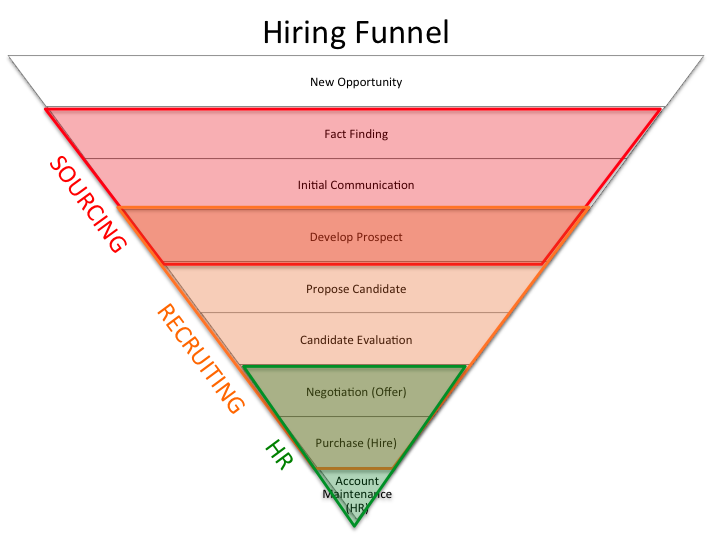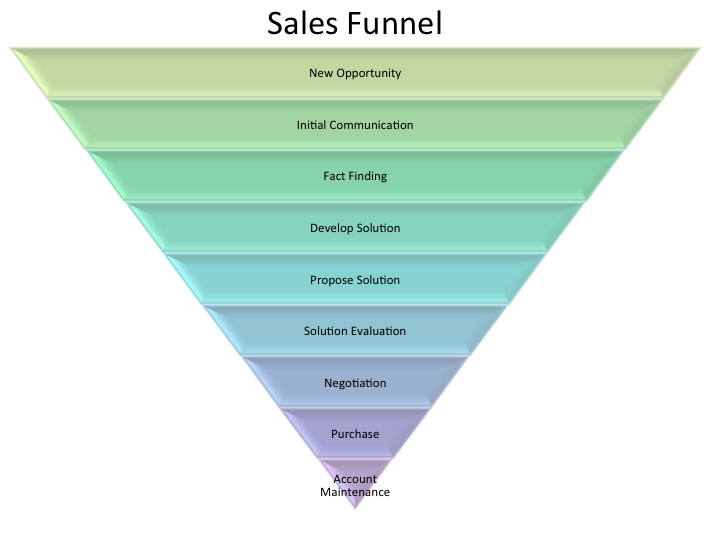The sales process is a step-by-step layout of what actions must be taken to turn prospects into customers. Regardless of how you look at it, recruiting is pretty much the same as product or service sales. The only difference is that our ‘product’ is a job opportunity and our ‘customer’ is a prospect (who hopefully turns into a candidate). As such, we approach the sales cycle in much the same way: targeting prospects, selling them on feature/benefits, closing a deal, and (hopefully) follow-up and account maintenance.
If you look at it through a recruiting lens, substitute sourcing for all the pre-sales activities, recruiting for sales and closing, and HR for account management.
It’s really that simple.
Depending on who/what you reference, a sales funnel will typically look something like the image above.
Just move a couple of these things around and – voila! – you’ve got a hiring funnel that includes sourcing, recruiting, and HR.

New Opportunity
This is when a new req is opened. Or, for more progressive and proactive organizations, this is the point in time when you’ve identified a future need and know that it’s time to start pipelining. That’s when the sourcing portion of the funnel kicks into gear.
Sourcing
Fact Finding
In a sales funnel, Initial Communication comes before Fact Finding, but when you’re hiring, important to do some digging first. We also call this competitive intel gathering or pre-research. This is where sourcers can really shine – this step in the process can yield information that can be beneficial to the entire organization. For example, let’s say you’ve recently identified the need to hire a team of engineers to design an updated version of an existing product. You find out that your biggest competitor has recently released a number of employees who were working on a product that would compete with yours. Not only does this provide you with some excellent potential candidates, but it also gives you some knowledge about what’s going on at your competitor – perhaps they are abandoning their product, or perhaps they are working on something new that your company should be aware of. A good sourcer will take this knowledge to other parts of the company and share it – it benefits more than just the team that needs to hire engineers.
Initial Communication
After a fun fact-finding mission, during which a good sourcer will discover additional information about prospects that can be used to ‘warm up’ the conversation, initial outreach is made. Check out this article that shares a very successful initial email that can be sent out to prospects. The more you discover during your fact-finding part of the process, the more success you can expect when doing initial outreach to your prospects.
Sourcing/Recruiting Handoff
Develop Prospect
At this point in the funnel, the line between sourcing and recruiting can get a little blurry depending on how your team is set up. Let’s substitute the word “Solution” for “Prospect” at this step in the funnel, because they are still not a viable candidate. Sometimes, it is a sourcer’s responsibility to ‘develop’ a prospect – which means they must conduct pre-screens to determine if basic qualifications exist. Other times, sourcers lob those prospects who’ve indicated interest to their recruiting counterparts to be screened for potential candidacy. There is no right or wrong answer here – it depends on the structure of your organization and where you choose to draw the line.
Something to keep in mind here: the funnel gets narrower the further into the process you get – making sourcing responsible for too many things too far into the funnel will make the job overwhelming and result in less quality at the top of the funnel. Please take this into consideration when deciding where the handoff point is between your sourcers and your recruiters.
Recruiting
Propose Candidate
Once prospect development has taken place and the prospect has been converted into a candidate, it is obviously the job of the recruiter to pitch the candidate to the hiring manager. Note: if your sourcers are making hiring manager introductions, then they are actually recruiters!
Candidate Evaluation
At this stage in the game, you can also switch around Candidate Evaluation and Propose Candidate depending on how you work with your hiring managers. Some recruiters like to pre-pitch candidates to hiring managers to share some highlights of the individual and determine if there is some interest prior to digging deeper into the evaluation/interviewing process. Other recruiters like to conduct these interviews before sending a candidate to the hiring manager. Again, there is no one correct answer here – it all depends on how you’ve chosen to structure your team.
Recruiting/HR Handoff
Negotiation (Offer)
While Recruiting is fully responsible for getting both the candidate and the hiring manager to this stage, it’s time for HR to step in and become involved in the process. If the recruiter has done his/her job up to this point, there should be very little haggling over compensation, benefits, and so forth, therefore making the transition from Recruiting to HR from here relatively easy. By recruiting and sourcing partnering up earlier in the process (at the development phase) and recruiting continually “checking in” with candidates to see where their thoughts are regarding the opportunity, the majority of candidates reaching this stage should be ready, and willing, to accept.
Purchase (Hire) and Account Maintenance (Onboarding and beyond)
These two stages in the funnel should be predominantly be handled by HR, though the recruiter should be involved with the actual hire itself and, if a good relationship was established by the sourcer, keep the sourcer looped in up to this point. From here on out, HR should lead the charge with ‘account management,’ but recruiters (as well as sourcers) should continue to maintain communication with the new hire – after all, new hires are excited about their new opportunity and can be an incredible source of referrals. And for corporate folks, they are your new co-worker!
Conclusions
No part of the funnel is more important than the other.
While this hiring funnel provides a great visualization of who is responsible for what and where, remember that every single component in this machine is important for the successful functioning of the organization as a whole. Without sourcing, there would be no prospects to recruit. Without recruiting, there would be no new hires for HR to onboard. And without HR, there would be no further career development and a lack of continuity in the whole process.
Duties are separated, but it takes teamwork to make a hire.
When deciding how to best work with your recruiting and HR counterparts, consider this as well as the sales funnel. By working together as a team and not saying, “That’s not my job!” you will have more success in bringing the best people onboard. They’ll see how well you work together and think, “I want to be part of a company that works so well together!”
Happy Sourcing!
